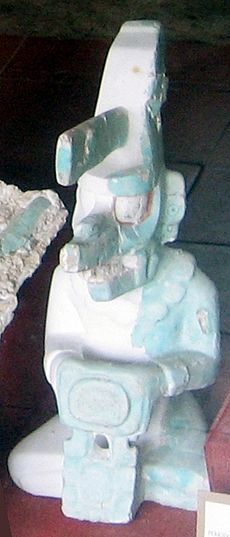Kʼawiil facts for kids
Kʼawiil was an important god for the ancient Maya people. He was known as the god of lightning, snakes, and good harvests. He also had a special connection to maize (corn), which was a very important crop for the Maya.
Kʼawiil is easy to recognize by his unique look. He has a head that looks like an animal, with big eyes and a long snout that points upwards. A torch, a stone axe, or even a smoking cigar often comes out of his forehead. One of his legs is shaped like a snake, which represents a lightning bolt. Because of this, Kʼawiil was seen as the lightning axe used by both the rain god and the Maya kings.
Contents
What Was Kʼawiil Called?
In the 1500s, in a part of Mexico called Yucatán, Kʼawiil was sometimes called Bolon Dzacab. This name means 'Innumerable maternal generations'. It might have been a way to talk about how fertile and productive he was. The number 'nine' (bolon) often appears in the symbols for this god, which connects to his name.
Today, experts usually call him Kʼawiil. This name comes from the Maya writing system. The symbol for Kʼawiil's head can stand for the sound kʼa in the word kʼawiil. This word might mean 'powerful one'. It was also a general title for gods in Maya documents. So, the name Kʼawiil became specifically linked to this lightning god.
Kʼawiil in Maya Stories
Lightning plays a big part in Maya stories about how the world was created. These stories explain how the world was made ready for people to live in it.
Creating the World
In the famous Maya book called the Popol Vuh, three lightning gods helped create the Earth. They were known as the 'Heart of the Sky'. One of them was Huraqan, who had only one leg. These gods created the land from the first ocean and filled it with animals.
Bolon Dzacab also has a role in creation stories, though it's not always clear. In another important Maya book, the Book of Chilam Balam of Chumayel, he is linked to wrapped-up seeds. It was believed that the rain gods, or their lightning, opened up the Maize Mountain. This act made corn seeds available for humans to plant and eat.
Kʼawiil and Maya Kings
Ancient Maya artworks often show Kʼawiil. For example, on the pillars of the Temple of the Inscriptions in Palenque, there are carvings of a king (and maybe a queen) holding a baby. This baby has a lightning axe on its forehead and a snake leg. This baby is the infant lightning god, sometimes called unen q'awiil. This young god was also one of the three special gods who protected Palenque.
Kʼawiil's Powers and Role
Kʼawiil was very important to Maya kings. He was connected to their power and how they became rulers.
Bringing Good Harvests
The Paris Codex, another ancient Maya book, shows that presenting Kʼawiil's head was part of a king's special ceremony. This ceremony happened when a new king took the throne. It might have promised 'Innumerable Generations' of good things.
Kʼawiil was not just about the king's power in war. He also helped the king bring good harvests to his people. Kʼawiil was a god of plenty, especially for corn and cacao seeds. Cacao is what chocolate is made from! Because of this, Kʼawiil is often shown with a bag full of grains. Sometimes, this image is joined by words that mean 'abundance' or 'plenty'.


